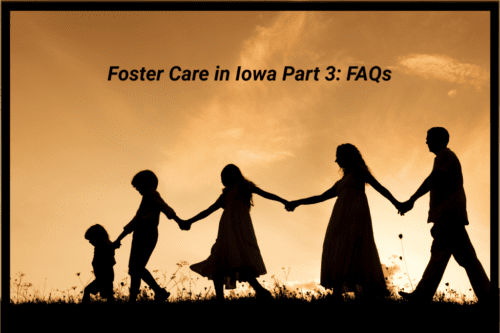Hopefully Foster Care in Iowa Part 1 and Foster Care in Iowa Part 2 gave you good insights about becoming a foster family and who are the kids in care. With so much information, I’m sure you have questions. (I know I did!) Keep reading for the answers to some frequently asked questions as well as answers to some questions you didn’t even know you had!

Foster Care FAQs
Q: How will we know if we would be a good foster family?
A: If you are considering foster care, you’ve already demonstrated the first good characteristic – willingness! You must be able to provide a safe and stable environment and open your heart and your home to a child in need. It also helps to be flexible and to have a sense of humor!
Becoming a foster family isn’t a decision to take lightly. During the process of taking the TIPS-MAPP (Trauma Informed Partnering for Permanence and Safety: Model Approach to Partnerships in Parenting) course and undergoing your home study, you’ll be asked to really examine your life. You’ll be asked to write about any anticipated big life changes and discuss them with your social worker. These may include moving, having a baby, taking a major trip, switching jobs, pending marriage/divorce, etc.
The Department of Human Services (DHS) recommends making the decision to become a foster family as a family. Children as young as about three will have some understanding of what it will mean to have a foster child. Older children will have an even greater understanding, and it’s important to address any concerns they have prior to accepting a placement.
Q: How, exactly, does a child come into our care?
A: When the Juvenile Court System or DHS determines that a child needs to be placed into foster care, they make a referral (in our area) to Four Oaks Family Connections where a placement social worker will work on finding a foster family. This process is called “matching” and refers to a child’s information being entered into a database for comparison to potential foster families’ information and preferences.
If your family is a match for a particular child (i.e., the characteristics and demographics of the child match up with your preferences for children you feel best able to foster), you will be contacted by phone, email, or text. You will be given information about the child – age and gender of the child, the reason for removal, any special needs or behaviors of the child, the anticipated length of care. You are free to ask specific questions as well.
If you feel your family is a match for the child, Four Oaks will notify DHS, and the child’s DHS worker will contact you about more specifics of the situation and the timeframe in which the child needs to be placed with you. More often than not, it seems like placements are urgent or emergent, at least in our experience. Once DHS notifies Four Oaks that the placement with you has been made, your Four Oaks support worker will contact you within five days to check in to see how you are doing with your new foster child.
Q: How big does my house need to be? Is there required square footage? Can foster children share a bedroom?
A: There are several specific requirements for a foster home. While there are no rules about the overall size of your home, each child must have at least 40 square feet of bedroom space. The bedroom must have permanent walls, a door that closes, a working window that opens from the inside (recommended at least 24 inches tall by 20 inches wide and not more than 44 inches off the floor), a closet or dresser, and a bed (couch beds, cots, or pack-n-plays are not allowed).
Children of the same sex may share a bedroom as long as each child has at least 40 square feet of space. Kids six years and older may not share a room with a child of the opposite sex. Children under two may sleep in the foster parents’ bedroom, but children two and older must be provided a bedroom adhering to the ’40 square feet of space’ rule.
Some additional things your home must have: smoke detectors, carbon monoxide detectors, fire extinguisher, all medications locked up, and posted emergency plans for fire/tornado/blizzard/etc.
Q: Can we still be a foster family if we have guns or other hunting equipment in the home?
A: Yes. There are very specific safety regulations for having guns, knives, bows, arrows, etc. in the home. All of these things must be kept locked up and inaccessible to any child. Ammunition must be kept locked up separately from any firearms. These are things that will be checked during your licensing home visits as well as follow-up visits.
Q: Do foster kids have contact with their biologic parents or siblings?
A: While the goal of foster care is reunification with the child’s biologic family, circumstances vary greatly. Your foster child may have visits with parents, siblings, or both. The frequency, location, and duration of these visits is highly dependent on why the child was removed from the home in the first place and how quickly reunification is expected to occur. Your role as a foster parent is to work in conjunction with DHS, your DHS worker, and the biologic parents to achieve reunification.
Q: How many foster children may be in my care?
A: When you get your foster care license, you will be licensed for a certain number of children, dependent on the capacity of your home. Families may be licensed for up to five children, but this includes your own biologic and adoptive children plus foster children. So if you have two children of your own, you may be licensed for three foster children, provided you have bedrooms for each of them. Occasionally, depending on circumstances, a variance may be granted for you to accept placement of more children than your license allows.
Q: What decisions can I make for foster children in my care? (e.g., Can I take them to the doctor? Can they go on vacation with us? Can I sign school permission slips?)
A: While you are providing the day-to-day care for your foster children, it is important to remember that the child’s parents still have legal authority to make decisions for their child. This includes giving consent for routine medical care, field trips and school activity involvement, travel out of state, obtaining a drivers permit/license, etc. Foster parents may authorize emergency medical care.
The foster parent is NEVER to sign as the child’s parent or guardian. You work with the social worker to either have that person sign or facilitate the parent signing any paperwork. The foster child’s parent may sign a general permission slip to keep on file at the school allowing for more “blanket” coverage.
Q: How will foster care impact my own children?
A: Having a foster child or children may bring up concerns for the well-being of your own children. Your children may experience jealousy when a new child comes into the home. Your children may also experience secondary guilt, knowing that the foster child needs your family but still having those feelings of jealousy. You may have concerns about negative behaviors of a foster child “rubbing off” on your own children. While this may occur, the flip side is that your children may serve as positive role models for the foster child.
There are ways to mitigate the potential negative effects on your children. Plan to spend special one-on-one time with your children as well as your foster child. Treat all the kids the same as much as possible. Keep as much of your children’s routine the same as possible.
You may periodically want to take a “time out” with your biologic family. This could be a vacation or weekend away. Each child in foster care entitles the foster family to 24 days of respite care per year. Respite care must be provided by another licensed foster family.
There will be emotions when a foster child leaves your family, too. Families may experience sadness, anger, relief, concern, fear, or guilt, among other things. The transition of a foster child back to his family of origin is often harder to understand for younger children. You will want to have a plan in place and communicate openly with your children at an age-appropriate level to help them with any big feelings they may have.
Q: What are some practical ways to prepare for having a foster child in our home?
A: You want your foster children to feel welcomed into your home. Remember they may be in a state of crisis, so you want to do everything possible to make them feel at home. If you have advance notice of a planned placement, you can prepare their bedroom with touches that may personalize it. For example, you may add some Teenage Mutant Ninja Turtle or unicorn décor if you know you’re getting a child who may like those things.
Often foster children arrive with very few clothes or clothes that are ill fitting or in rough shape. You could get a few gender/size appropriate clothes if you know about a placement in advance of the child’s arrival. You may also consider having a few pieces of clothing in varying sizes and styles for placements you receive with short notice. It will also be important for older children to have the opportunity to pick out some clothing of their choice, to have a sense of ownership. This could be an activity you do with the child after he is settled into your care.
Foster families often have a “Welcome to Our Family” binder with information and photos of your family members and pets, your home, your neighborhood, foods your family likes to eat, what you do for fun, your extended family members, the school your children attend, holidays you celebrate, and family rules. For a planned placement, your social worker could provide your foster child with the binder ahead of time. For a short-notice placement, you can sit with your foster child and talk about these things with her after she gets settled in.
Q: What documentation do we need to complete as a foster family?
A: Once you have a placement, much of the paperwork you need to complete is record keeping. It is important to document things so there is information about the child in your care as well as for your protection. You may need to keep a medication log, a behavior log, a log of family visits, documentation of court proceedings/appearances, an inventory of what a child arrived in your home with, incident reports, contact log with the child’s social worker, etc.
It is recommended that you have a foster care binder for each child in your care. In addition to the above documentation, you will also want to keep basic information about the child, a sheet with the contact information for the child’s social worker, your support worker, the child’s attorney or guardian ad litum, a calendar of appointments, a mileage log, etc.
While this sounds a little overwhelming, if you are organized and have a system, this documentation can pretty quickly fit into your routine.
Q: What if I have a relative child going into foster care? Can we be the foster family?
A: In many cases, yes! You may have a relative child who already lives with you or stays with you. You may know of a relative child who is going to be removed from their home. Every situation is a bit different, but Four Oaks has a good resource which covers a range of circumstances.
Q: What kind of support will we have as a foster family?
A: The initial training process, your home study, the placement of children into your care, and ongoing training can all seem somewhat daunting when you start out as a foster family. The good news is that there is a good built-in support system for you! Here are some of the individuals who will teach you, support you, answer your questions, and serve as a resource to you:
- The instructor(s) for your TIPS-MAPP class
- Your licensing worker – this will be the social worker who helps you through the home study process while you are taking your TIPS-MAPP class.
- Your case worker – this will be the social worker assigned to you as a foster or adoptive family. This person will be your resource for questions, help you interact with birth families, advocate for your child in school, help you find respite care, and more.
- Mentor family – You may request to be paired with another more experienced foster family who understands the day-to-day of what it means to be a foster family.
- Adoption case worker – If you are adopting, you will have a case worker to help you navigate that process.
- Iowa Foster and Adoptive Parents Association (IFAPA) – This non-profit organization serves Iowa’s foster and adoptive families by providing support, advocacy, information, and education.
Hopefully these FAQs helped answer your questions – even those you didn’t know you had! For further information or to start the process of becoming a foster family in Iowa, you can check out the Four Oaks website.










